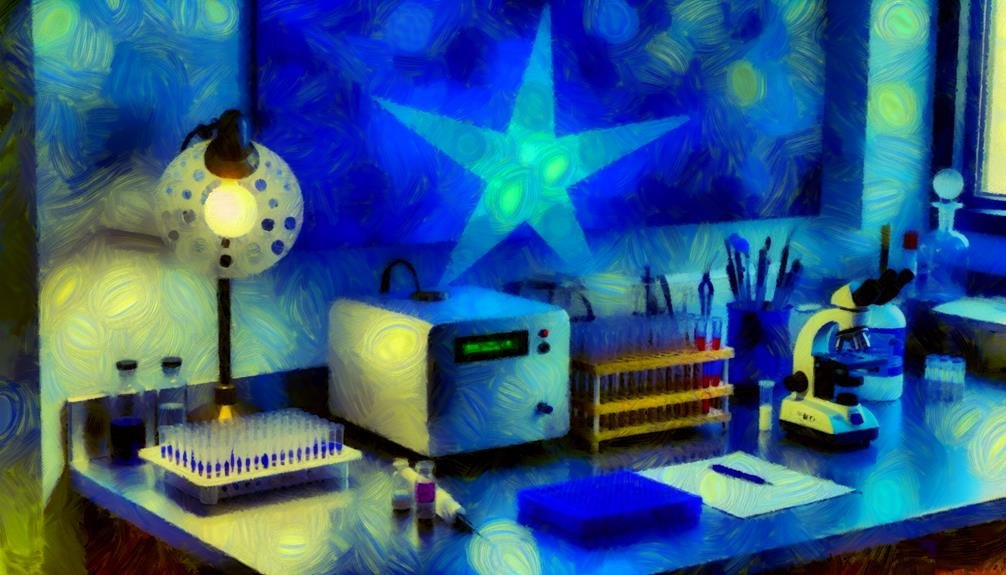Polymerase Chain Reaction (PCR) is an innovative technique that allows for the rapid amplification of specific DNA sequences. Its advantages include high sensitivity and specificity, enabling the detection of minimal DNA quantities, which proves essential in medical diagnostics and forensic science. PCR is efficient, producing results in hours, thereby facilitating timely interventions. Nevertheless, PCR also has limitations; it is highly sensitive to contamination, can struggle with degraded samples, and requires prior sequence knowledge for primer design. The balance of these pros and cons considerably influences its applications, revealing more about its role and future in molecular biology and diagnostics.
Main Points
- High Sensitivity and Specificity: PCR can detect minute DNA amounts, making it valuable for diagnostics and research with minimal false positives.
- Rapid Results: PCR provides results within hours, significantly faster than traditional methods, enhancing timely decision-making in medical and forensic contexts.
- Contamination Risks: PCR is sensitive to contamination, which can lead to false positives from extraneous DNA, potentially compromising results.
- Cost Considerations: Initial equipment and ongoing operational costs can be substantial, affecting budget allocation for laboratories and law enforcement.
- Limitations with Unknown Pathogens: PCR requires prior knowledge of sequences for primer design, limiting its effectiveness for detecting unknown pathogens.
Overview of PCR
Polymerase Chain Reaction (PCR) is a groundbreaking technique in molecular biology that allows for the amplification of specific DNA sequences, making it possible to generate millions of copies from a minimal starting sample. Developed in the 1980s by Kary Mullis, PCR has revolutionized genetic research, diagnostics, and forensic science.
The procedure involves three primary steps: denaturation, annealing, and extension. During denaturation, the double-stranded DNA is heated to separate it into two individual strands.
In the subsequent annealing phase, short sequences of nucleotides known as primers bind to the target DNA sequences. Finally, in the extension phase, a DNA polymerase enzyme synthesizes new DNA strands by adding nucleotides that are supplementary to the template strands.
This cycle is repeated multiple times, typically 20 to 40, resulting in exponential amplification of the target DNA segment. PCR is highly specific, enabling researchers to isolate and study particular segments of DNA with precision.
Its versatility allows it to be applied in various fields, including medical diagnostics, environmental monitoring, and biological research. Understanding the fundamental principles of PCR is essential for leveraging its capabilities in scientific exploration and practical applications.
Advantages of PCR
The advantages of PCR are substantial, particularly its high sensitivity and specificity, which allow for the accurate detection of even minute amounts of DNA.
Additionally, PCR offers rapid results, making it an efficient tool in various applications, from clinical diagnostics to research.
These characteristics underscore PCR's crucial role in molecular biology and its impact on advancing scientific understanding.
High Sensitivity and Specificity
One of the most considerable advantages of polymerase chain reaction (PCR) is its high sensitivity and specificity in detecting genetic material. PCR can enhance minute quantities of DNA, making it possible to identify pathogens or genetic mutations even when present in very low concentrations. This characteristic is particularly useful in clinical diagnostics, where early detection of infectious diseases or genetic disorders can greatly influence treatment outcomes.
The specificity of PCR is derived from the use of primers that are designed to bind to unique sequences of the target DNA. This guarantees that the amplification process primarily targets the intended genetic material, minimizing the risk of false positives. Consequently, PCR is widely utilized in various fields, including medical diagnostics, forensic science, and environmental monitoring.
Moreover, the high sensitivity and specificity of PCR contribute to its reliability, allowing researchers and clinicians to trust the results for decision-making. By providing accurate and precise detection, PCR has revolutionized molecular biology, enabling noteworthy advancements in genetics and genomics.
All in all, the high sensitivity and specificity of PCR underscore its critical role in modern scientific and medical practices.
Rapid Results and Efficiency
Rapid results and efficiency are considerable advantages of PCR that complement its high sensitivity and specificity. The ability to obtain results quickly is crucial in various applications, particularly in clinical diagnostics and infectious disease management. PCR can greatly reduce the time required to detect pathogens, enabling prompt treatment and containment measures.
The efficiency of PCR is reflected in several key aspects:
- Time-Saving: Conventional methods can take days to weeks for results, while PCR can deliver findings within hours, thereby accelerating decision-making processes.
- Minimal Sample Requirement: PCR requires only small amounts of DNA or RNA, allowing for the analysis of samples that may be limited in quantity, which is particularly beneficial in clinical settings.
- Scalability: PCR can be easily scaled to accommodate a high throughput of samples, making it suitable for both small-scale research and large-scale screening initiatives.
These advantages underscore PCR's crucial role in modern diagnostics, showcasing its capability to improve both the speed and accuracy of pathogen detection while facilitating timely intervention.
Limitations of PCR
Numerous limitations exist when utilizing Polymerase Chain Reaction (PCR) for molecular diagnostics and research applications. One notable constraint is its sensitivity to contamination, which can lead to false-positive results. Even minute quantities of extraneous DNA can enhance during the PCR process, complicating interpretation and undermining diagnostic accuracy.
Another limitation is the requirement for prior sequence knowledge of the target DNA, as PCR necessitates the design of specific primers. This prerequisite can restrict its application in detecting unknown pathogens or novel genetic sequences.
PCR is also limited in its ability to quantify DNA accurately. While quantitative PCR (qPCR) addresses some of these concerns, variations in enhancement efficiency can still lead to inconsistent results. Additionally, PCR may not reliably detect DNA present in low quantities or in degraded samples, limiting its effectiveness in certain clinical scenarios.
Furthermore, the reliance on thermal cycling can introduce biases, particularly in samples with complex mixtures of DNA, potentially leading to preferential enhancement of certain sequences over others.
These limitations underscore the need for careful consideration when employing PCR in both diagnostic and research settings.
Applications in Medicine
Polymerase Chain Reaction (PCR) has become an essential tool in modern medicine, transforming the realm of diagnostics and therapeutic monitoring. Its ability to amplify specific DNA sequences has led to noteworthy advancements in various medical applications, improving both the speed and accuracy of disease detection.
The key applications of PCR in medicine include:
- Infectious Disease Diagnosis: PCR allows for rapid identification of pathogens, including bacteria and viruses, facilitating timely treatment decisions and infection control.
- Genetic Testing: PCR is vital for detecting genetic disorders and mutations, providing critical information for personalized medicine and risk assessment in hereditary conditions.
- Oncology: In cancer diagnostics, PCR aids in the detection of tumor-specific markers, enabling early diagnosis, monitoring of treatment responses, and assessment of minimal residual disease.
These applications underscore the versatility and importance of PCR in medical practice.
By offering precise, rapid, and reliable results, PCR not only improves patient outcomes but also informs public health strategies, illustrating its essential role in the healthcare arena.
As technology continues to evolve, the potential for PCR in medicine is bound to expand further.
Role in Forensics
While the application of PCR in medicine is well acknowledged, its role in forensics is equally important, providing a powerful tool for criminal investigations and legal proceedings. PCR, or polymerase chain reaction, enables the amplification of minute quantities of DNA found at crime scenes, making it possible to analyze genetic material from blood, hair, saliva, and other biological samples.
One of the key advantages of PCR in forensics is its sensitivity; it can detect DNA even in degraded or contaminated samples. This capability is crucial in cases where traditional DNA profiling methods may fail. Additionally, the specificity of PCR allows forensic scientists to target specific regions of the DNA, enhancing the accuracy of results.
In addition to identifying suspects, PCR can also exonerate innocent individuals, highlighting its ethical consequences in the justice system. By generating reliable evidence, PCR contributes to the integrity of investigations and trials, ensuring that justice is served effectively.
As forensic techniques continue to evolve, PCR remains a cornerstone of modern forensic science, bridging the gap between molecular biology and criminal justice, and reinforcing the importance of scientific rigor in legal contexts.
Cost Considerations
Evaluating the cost considerations associated with PCR is essential for both forensic laboratories and law enforcement agencies. The financial consequences of implementing PCR technology can greatly influence decision-making processes. Understanding these costs is vital for effective budgeting and resource allocation.
Here are three key cost factors to take into account:
- Equipment and Supplies: Initial investment in PCR machines and necessary reagents can be substantial. High-quality thermocyclers and consumables can range in price, impacting the total setup cost.
- Operational Costs: Beyond the initial purchase, ongoing expenses include maintenance, calibration, and the cost of consumables such as primers and enzymes. These recurrent costs can accumulate over time, affecting the laboratory's budget.
- Training and Personnel: Skilled personnel are essential for accurate PCR testing. Training costs for existing staff or hiring specialized technicians can add another layer of expense, which should be factored into the total cost assessment.
Future of PCR Technology
The future of PCR technology promises considerable advancements that could improve its efficiency and applicability across various fields, including medicine, forensics, and environmental science.
One of the most notable developments is the integration of digital PCR (dPCR), which offers enhanced sensitivity and quantification capabilities. This technology allows for the precise measurement of nucleic acid quantities, facilitating early disease detection and personalized medicine approaches.
Additionally, advancements in microfluidics and automation are clearing the path for high-throughput PCR systems that can process multiple samples simultaneously, greatly reducing turnaround times in clinical diagnostics and research settings. These innovations will likely make PCR more accessible, particularly in resource-limited environments.
The incorporation of artificial intelligence and machine learning into PCR analysis is also anticipated to improve data interpretation, leading to more accurate results and quicker decision-making processes.
Moreover, the development of isothermal amplification techniques may provide alternatives that circumvent some limitations of traditional PCR, such as the need for thermal cycling equipment.
Common Questions
How Does PCR Differ From Other DNA Amplification Methods?
PCR, or polymerase chain reaction, uniquely employs thermal cycling to increase specific DNA sequences exponentially. Unlike other methods, it utilizes short primers and heat-stable DNA polymerases, allowing for rapid and precise increase under varying temperature conditions.
Can PCR Be Used for RNA Analysis?
Polymerase Chain Reaction (PCR) can indeed be utilized for RNA analysis through a process called reverse transcription PCR (RT-PCR), where RNA is first converted into corresponding DNA (cDNA) before amplification, enabling gene expression studies.
What Are Common Contaminants Affecting PCR Results?
Common contaminants affecting PCR results include residual DNA from previous experiments, enzymes, chemicals from reagents, and environmental factors like dust or aerosols. These contaminants can hinder amplification and compromise the accuracy of PCR outcomes.
How Does Temperature Influence PCR Efficiency?
Temperature notably influences PCR efficiency by affecting enzyme activity, denaturation, annealing, and extension rates. Ideal temperature conditions improve specificity and yield, while deviations can lead to incomplete amplification or non-specific products, ultimately affecting the results.
Is PCR Suitable for Ancient DNA Testing?
Polymerase chain reaction (PCR) is suitable for ancient DNA testing, although it presents challenges due to DNA degradation and contamination. Optimized protocols can improve amplification, enabling significant understandings into historical genetic material when employed carefully.
Conclusion
In conclusion, polymerase chain reaction (PCR) serves as a crucial tool in molecular biology, offering numerous advantages such as sensitivity and specificity. Nevertheless, limitations including potential contamination and dependency on high-quality samples exist. Its applications span medicine, particularly in diagnostics, and forensics, improving investigative processes. Cost considerations play an important role in accessibility and implementation. Continued advancements in PCR technology promise to further improve its effectiveness and broaden its applications, ensuring its relevance in scientific research and practical applications.

